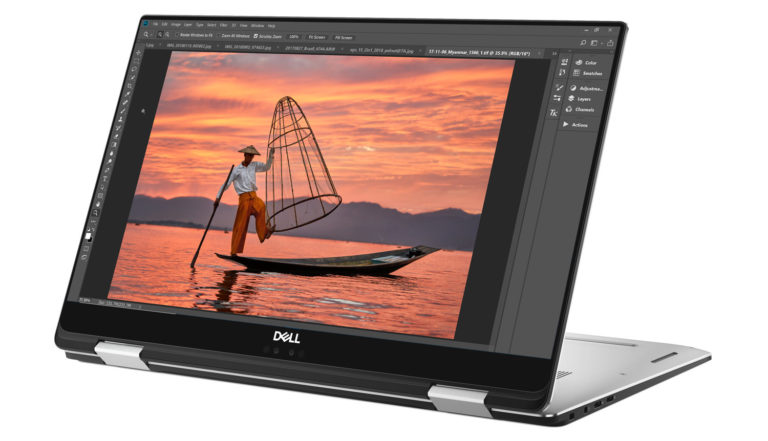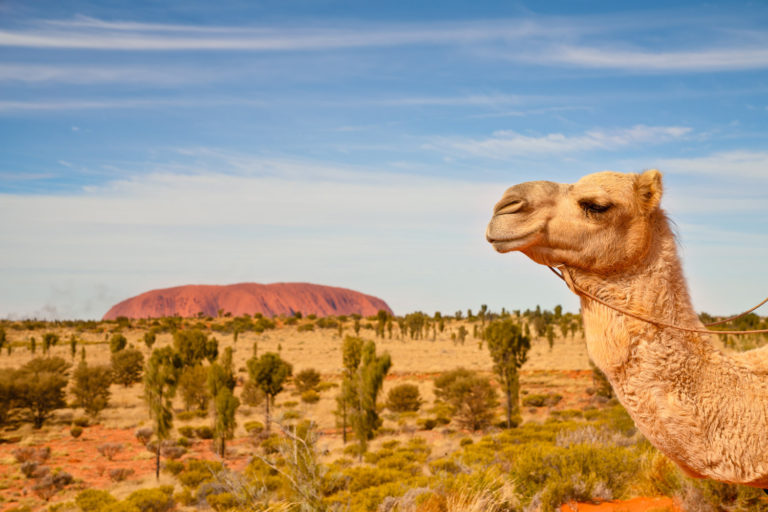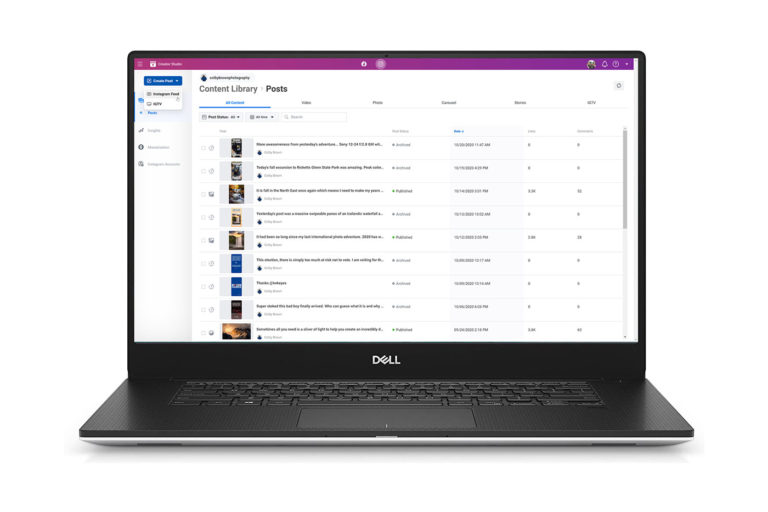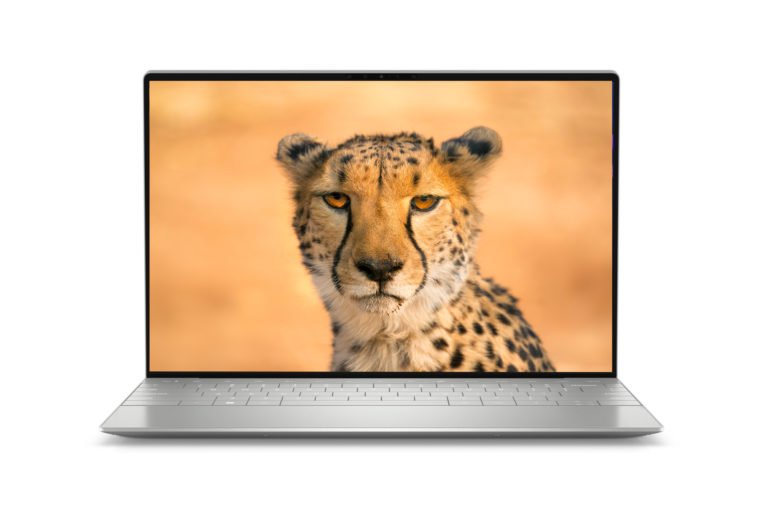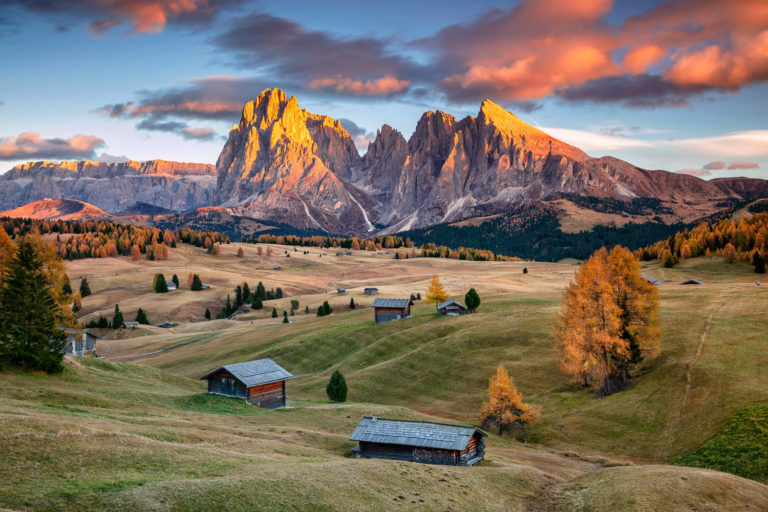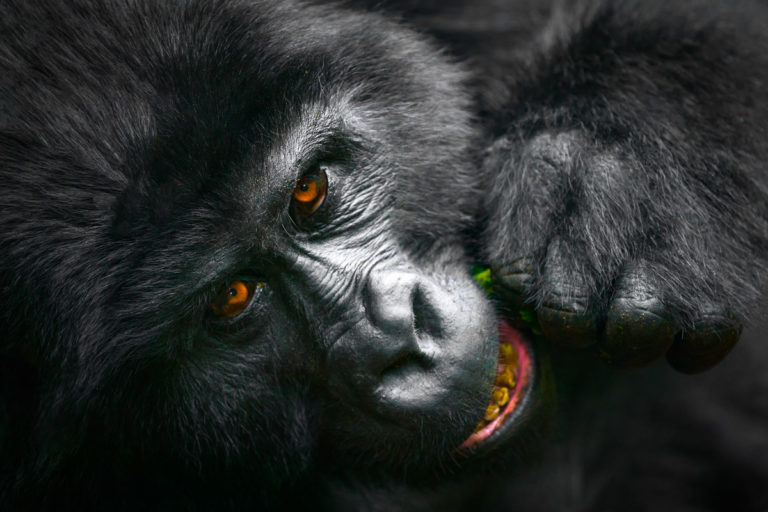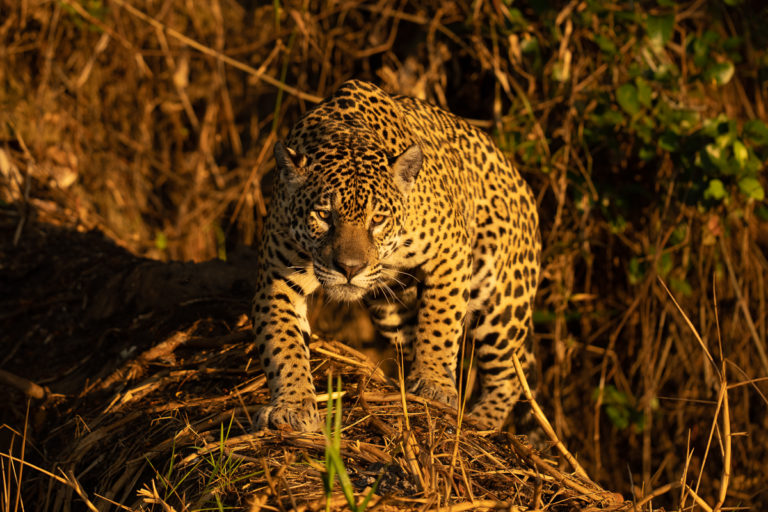When it comes to being a photographer, there is no shortage of online networks waiting for you to share your images, interact with others and potentially grow your business. From Google+ to Facebook, Twitter to Pinterest, 500px to Flickr, you have more options at your disposal now then ever before. But what really is Social Media? Why is it so important? Which networks are best for your needs? And most importantly, what are some of the ways that you can maximize your time on each of the major networks? Over the next few weeks, I will be releasing a series of posts titled “Social Media for Photographers”. While I will be giving a broad over view of social media here today, each subsequent blog post will cover a specific social network, allowing you to have a more in depth look at the positive and negative aspects of nearly all of the choices out there.
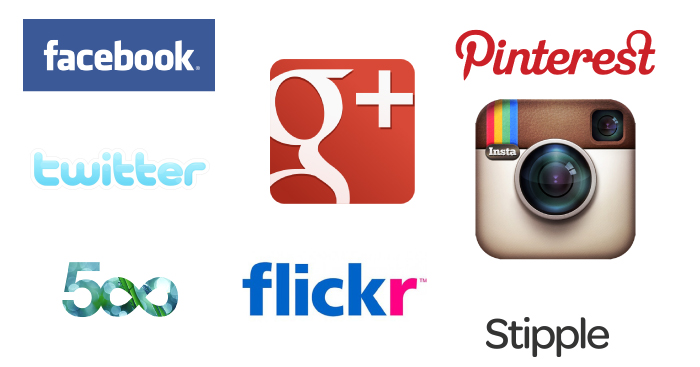
Lets get started…
What is Social Media?
According to Wikipedia, which I hate using as “source” even if it seems fitting for this subject matter, says that “Social media is web and mobile-based technologies which are use to turn communication into interactive dialogue among organizations, communities and individuals”. To be fair, this definition is pretty spot on. So many people look at Social Media and Social Networks as this incredibly foreign concept, when in reality it is just about giving you the potential to connect and communicate with people around the world. Figuring out what you do with that potential connection, is the challenge. Not every photographer on a social network is there to make money. Some might be looking for inspiration, others for education. Regardless, if you begin to look at social media networks as simply digital platforms that allow you to personally connect with other individuals, your anxiety and uncertainty about jumping in might begin to fade.
The old school methods of marketing and advertising are not only antiquated, they have lost much of their value. Why? Because companies and individuals are beginning to understand that spending $30,000 for an ad to run for a single month in Outdoor Photographer with the hopes of it capturing a potential customers attention for the 1.2 seconds they have to make an impression is not the best use of money anymore. Instead companies are developing full social marketing teams to find ways to connect with new customers in more personal and vital ways than ever before.
Why are Social Networks Important?
If we can all accept the fact that social networks are platforms that give you the chance to connect with individuals from all over the planet, we should know exactly how much potential reach that might include. According to the Internet World Stats website, in 2011 there were 2,267,233,742 active Internet users in the world. This breaks down to roughly 32.7% of the entire population of this planet. Any guesses to how much of a % increase that was from 2000?
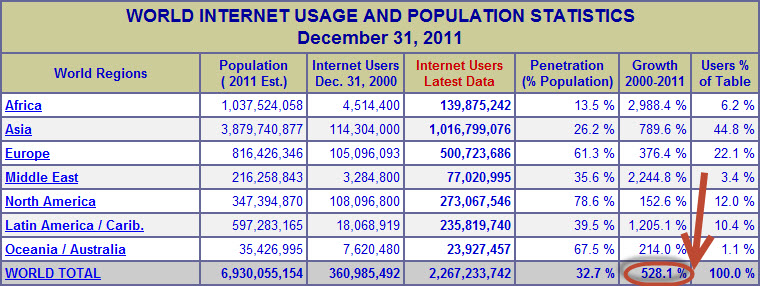
If you guessed (or simply looked at the chart above), you would have seen that there was a 528.1% increase in Internet users world wide between 2000 & 2011. That is a pretty staggering number. Some other interesting statistics can be found in this study. North America for example, had roughly 78.6% of its entire population go online, however they only account for 12% of the overall Internet users worldwide. Asia on the other hand had the most Internet users by far with 1,016,799,076, which equated out to 44.8% of all active Internet users, but only 26.1% of the regions total population. Knowing this information will become more relevant later in the blog post. Considering the trajectory of these numbers, one can assume that this trend will only continue to increase as a.) technology continues to advance at break neck speeds b.) the world’s population continues to sky rocket and c.) as a species we continue to become more accustomed to using the Internet in our daily lives.
In the past, one had to spend large sums of money on flyers, advertisements and mailers with the hopes that hopes that those you sent this material cared enough to see it in the first place. Now you have potential access to billions of people through the Internet and these social networks. Anyone care to go back to the “good ole days”? Not me!
The Social Age of the Internet
Now to truly understand the importance of Social Media, you need to understand where we are in relation to the lifespan of the Internet. In the last 24 months, we have successfully entered the 3rd generation of the Internet. While the 1st generation had a focus on content with the .Com explosion, the 2nd generation was all about making that content dynamic. A great example of this is the phenomenon that became streaming video (YouTube & Vimeo come to mind). The 3rd generation, where we are presently, is all about trusted content…effectively the “social” age of the net. Now what do I mean by trusted content?
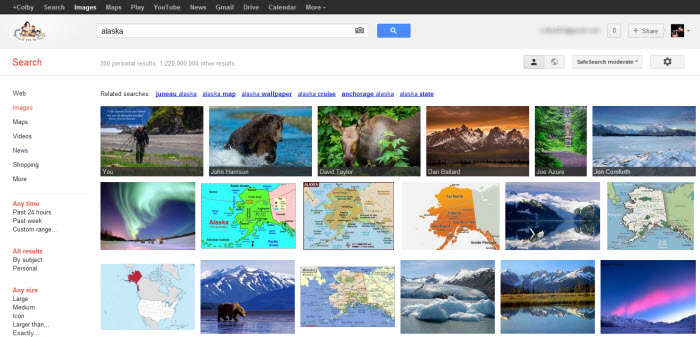
In life, real life that is, most of us put a high value on information that comes from someone we know. The better we know them, the higher the value. For example, if my wife told me that her massage therapist was the best in the world and that I should go in for a session, I would take her at her word. However if some random guy walked up to me in the parking lot of Whole Foods Market and told me the same thing…I might be a little worried. That same principle applies to the Internet in this new social age. How it applies is actually very simple. Contrary to popular belief, Facebook and Google (arguably the two largest companies on the Internet) are at their core ADVERTISING companies. While both provide free services and products, I am sure we are all smart enough to know that nothing in life is truly free. This means that the bulk of their revenue actually comes from providing advertisements to you and I as we use their networks for our own means.
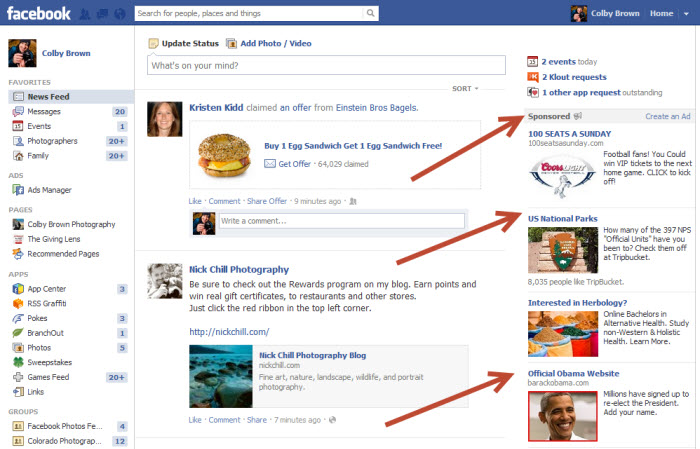
Now for those of you that have never taken an advertising class in college, the general idea is to present a product or service to individuals that are more likely to want or need said product or service. In the past this was done through data mining of past purchasing patterns, surveys and membership card programs, but the problem was that the data never told the whole story. Google, Facebook and other social networks are now taking this formula to the next level. How? Everytime you LIKE, +1, COMMENT and RE-TWEET content on any of these networks, that information is not only being stored, it is being studied. These companies want to not only know what what content you have interacted with in the past, they want to know how much you trust those you have connected with online. This however is done not only to offer more accurate advertisements, it is also done to help combat NOISE in most social networks.
What is Noise?
When it comes to Social Media, noise is one of the most important variables to understand as an end user or a business. Noise is effectively all of the content published online that an individual does NOT want to see. This can be spam, an unwanted marketing pitch or even a photograph that we do not care for. Effectively it is content that gets in the way of the content that we actually want to see and interact with. Most networks combat this issue with advanced filters (mathematical algorithms) that’s sole purpose is to show us the content it thinks we want to see. THIS IS IMPORTANT. If you have 200 “fans” on your photography Facebook page, not everyone will see every post you publish…even if they were all online starring at their news feed as you published a post. Why? Because Facebook’s noise filter attempts to determine which of your followers wants to see the content you published in order to maintain order on its network.
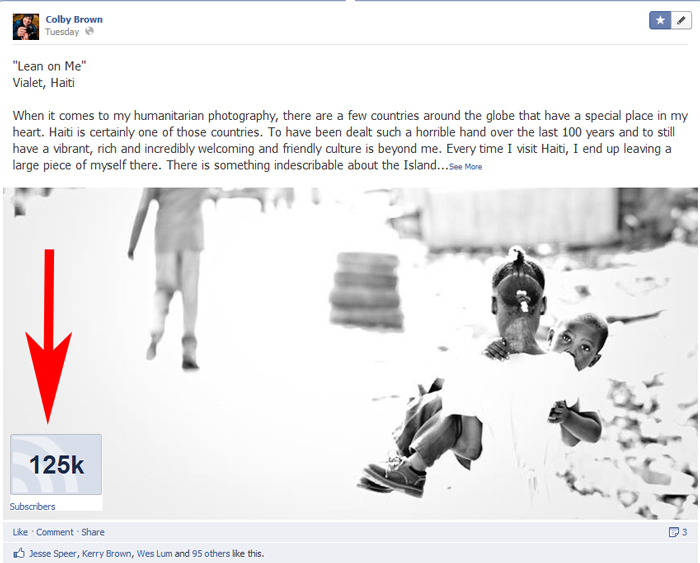
With 950 million active users on FB, there would be chaos if everyone saw everything from everyone they connected with. This is also a good time to point out that Facebook weighs content differently depending on where it is coming from. A business/fan page is valued differently from a personal profile…in fact it weighs its value less from within the noise filter in Facebook. What do I mean? If you have 200 followers on your Facebook personal profile and the same 200 followers on your photography fan page and you had the ability to post the same image in both places at the same exact time, the image being published from your fan/business page would automatically be seen by less people than your personal page. Why does Facebook do this? The most obvious answer is money. They want you to pay for your posts to be seen by your followers when running a business page. That is what the new “promoted stories” option actually is. Paying to have your posts seen by more people that already follow you in the first place. This is one of the core reasons that many photographers are abandoning their Facebook fan/business pages and instead taking advantage of the new “Subscriber” model on their personal profile. But I will get more into this on my post about Facebook specifically in the coming weeks.
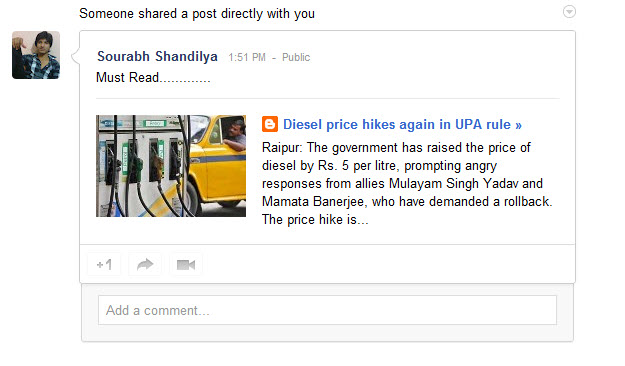
Noise is something that everyone has to compete with. If you want an image or a specific post to reach a certain number of individuals, you have to plan accordingly. The words you use, the type of content (internal upload vs hyperlink vs RSS feed) and the time of day all play a crucial role in getting the most of our your social media experience and while working around the challenge of noise drowning out your content on the network. A fundamental understanding of noise and how social networking noise filters work will help you get a few steps ahead of the game.
* It is important to point out that Twitter does not have any such filter. You will ALWAYS see all of the content being “tweeted” from those you to follow on the network. This is also one of the reasons that many people feel Twitter is way to chaotic. We will talk more about this soon…
What Social Networks Are Out There?
As I discussed earlier, when it comes to the sheer number of social networks that you as a photographer have access to, the number can be some what intimidating. How many people truly know which networks they should be on or where they should focus their limited time and energy? I imagine that most are simply guessing. So lets do a fairly simple break down of each of the networks, their positive and negative traits and which each Network is good at offering different types of photographers.
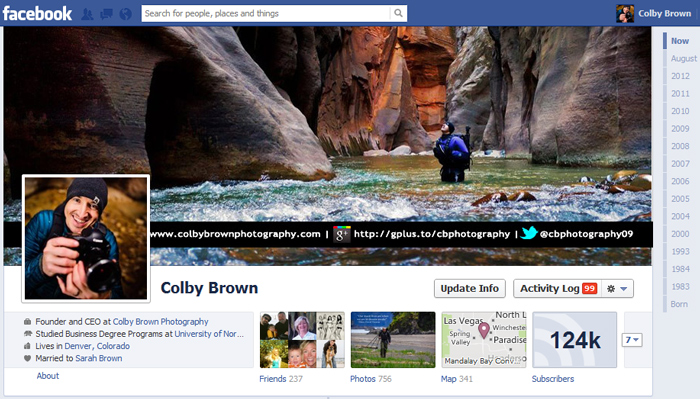
Name: Facebook
User Base: 950+ Million Users (public information)
The Positives:
- Facebook is the largest social network in the world in terms of users
- More likely than not, your friends, family and co-workers are already on the network
- Facebook is working hard to improve its mobile applications
- “Subscriptions” solved the limitation problem with only being able to have 5,000 Facebook friends
- Did I mention that everyone and their mother is there already?
The Negatives:
- The vast majority of users are there to stay connected with their friends, family and co-workers..not to purchase products or engage with people they don’t know.
- The small group mentality makes it difficult to build a following. Think I am wrong, start a Photography Fan Page and find out for yourself 🙂
- Facebook still has a problem with Image compression (meaning their system compress your image in ways that may make your photograph look worse than it actually is)
- Facebook has a public perception issue when it comes to privacy
- Facebook is the least liked Social Network in terms of Customer Satisfaction, ranking in at 61% (LINK)
- Facebook’s IPO has dropped over half of its value since it went public because of a lack of investor confidence
- Overall Interest in Facebook has dropped over the years where many users are not excited to be there any more, instead they are on the network simple because that is where their friends and family are. In the long run, this is a huge problem.
Summary
If you are a photographer that shoots portrait, wedding, event or local sports photography than you will have a higher chance of finding clients on Facebook than most of the other networks. If you shoot landscape, travel, adventure sports or nature photography, you have better outlets on other networks to try to make print sales or get your work seen by more people. If you are looking for inspiration, education or a photography community to connect with, I have found that Facebook falls short. Flickr, Google+ and 500px all over a much more robust and open community if you are looking for those things.
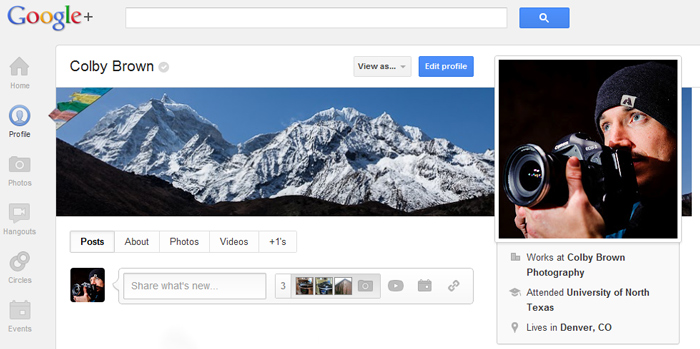
Name: Google+
User Base: 336 million active users (Global Web Index)
The Positives:
- Google+ is the social layer for ALL things Google, it is not just a social network
- Great UI (User Interface). Your images will look beautiful
- Solid privacy controls
- A thriving Photography Community has established itself on the network
- Google+ Hangouts (Free video conferencing with up to 10 people from anywhere in the world)
- Google employees are very receptive to feedback to improve the user experience
- The mobile experience is gorgeous and fluid
- All public content is indexed for Google search
- Being active on Google+ increases your chance of improving your standing in search results (will explain in the Google+ specific post)
- Google+ users have the highest amount of customer satisfaction among social networks (LINK)
- Google just purchased NIK SOFTWARE. What this means for Google+ and Android, we don’t know just yet.
The Negatives:
- Google+ still has a negative public image. The words “ghost town” are used when describing the network by tech journalists, even though it is far from the truth
- Your friends, family and co-workers will most likely not be on G+
- Google is still very young when it comes to understanding digital social dynamics. AKA their NOISE filters are not as good as they should be
- Google has yet to release the API which allows users to post to Google+ from other applications
- Google+ is NOT Facebook, which means that new users sometimes have a hard time getting their feet wet because they try to treat it like it is
Summary:
Google+ is a great network if you are looking for inspiration, education, a photo community or if you are a photo educator. In its current form, you will find it more challenging to book clients if you are a portrait, wedding, event or local sports photographer. Its structure and feature set are geared towards promoting engagement and giving plenty of opportunities to connect with other photographers and photography centered companies, especially with the Google+ Hangout feature. However its biggest draw for photographers will be that Google indexes all public posts to be searchable in their search engine, which equates to over 64% of all search online (more on this in the Google+ specific blog post). Bottom line, if you are active on Google+, you have the potential to drastically effect your own search results.
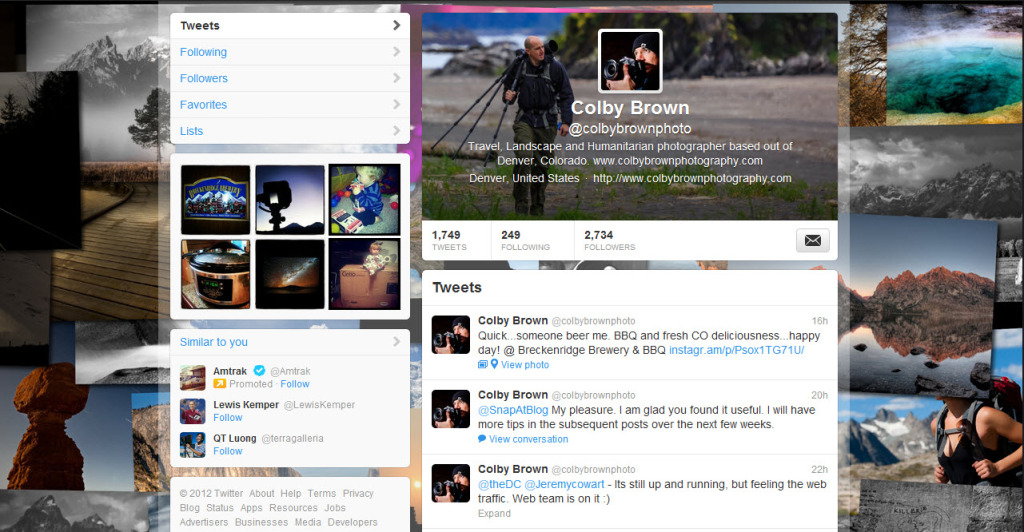
Name: Twitter
User Base: 517 million twitter accounts, although only 262 million are active Global Web Index)
The Positives:
- Simplistic form of communication, every “tweet” is limited to only 140 characters..the same as a text message
- Instant communication gives you access to directly connect with other individuals and companies in the blink of an eye
- News has been found to be breaking on twitter before anywhere else
- There are no NOISE filters, which means everything you post is visible, but competing with all other content on Twitter
- The use of Hashtags (#keyword) allows for easy search results to find the tweets you want
The Negatives:
- You are limited to 140 characters per “Tweet”
- Twitter is polarized within its user base. Most either absolutely love it or have no clue what to do with it. Very little in between
- Looking at a twitter feed can be intimidating because content is flying at you very fast
- Only half of the users with accounts are active (517 million accounts – 262 million active users)
- Of the 3 most popular social networks, it has the least amount of users (Facebook, Google+ and Twitter)
Summary:
Twitter is a phenomenal tool to instantly connect with individuals and companies around the world. While its fast pace and constant flow of content will be a put off the many, the fact the news is beginning to break on twitter before anywhere else online is a great example of the value of the network for spreading content and information. Will you sell prints or find new wedding clients? Mostly likely not…although it is not impossible. I look at Twitter as the worlds quickest communication tool to communicate with others directly, speak to a business about a problem or easily share the content I am publishing on my website.
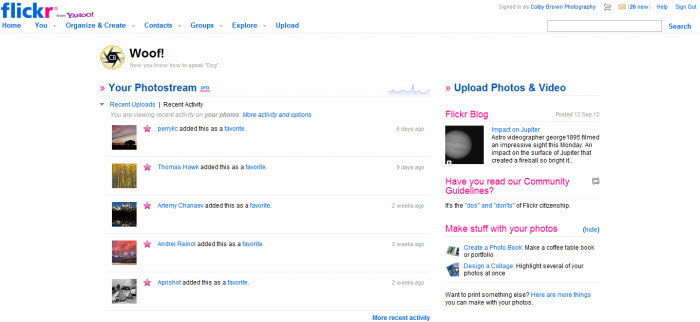
Name: Flickr
User Base: 80 million unique visitors world wide (A June 2011 report from Yahoo)
The Positives:
- Flickr is an “Interest Network”, which means that its focus is purely on sharing images
- 4.5 million photos are uploaded to flickr every day (Source is same link as above)
- Your images receive very little image compression once uploaded to Flickr, which means they look closer to the same image viewed on your computer than other social networks
- You can licence images to Getty straight from Flickr
- I know many photographers that make plenty of print sales from being active on Flickr
The Negatives:
- Yahoo as a company is struggling to stay relevant in an Internet that has passed them by
- The interaction on Flickr is not very exciting or personal
- The look of Flickr itself is VERY outdated
- People are not as excited about Flickr as they once were. Most professionals I know have moved on from the network.
Summary:
If you are looking to licence images or try to make print sales, Flickr might be a good choice for you. However because of its outdated look and fairly stagnant forms of interaction, the network itself has lost its luster for many photographers, myself included. Do I hope that Flickr re-invents itself? Absolutely. But I am not holding my breath as there are plenty of other options in the social networking world that fill the gaps left by my lack of activity on Flickr.
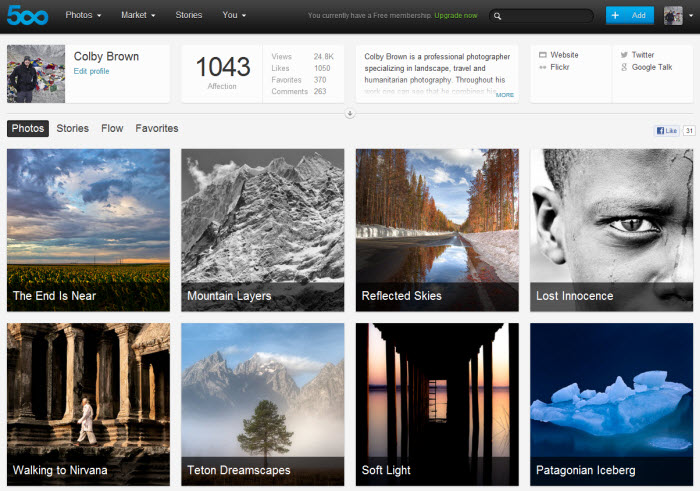
Name: 500px
User Base: No exact # of users, but a very conservative estimate was over 90k unique visitors a month on average (not confirmed)
The Positives:
- 500px, like Flickr, is an Interest network where the sole purpose is to share beautiful photographs
- It is a phenomenal place to find photographic inspiration
- Images look beautiful on the network
- 500px relies on crowd sourcing for ranking images, which effects how visible an image is. The higher the rating, the better chance the image will be seen by others
- You can now sell prints through 500px (via “Awesome” or “Plus” Membership only)
- You can use 500px as your Portfolio/Website (via “Awesome” Membership only)
The Negatives:
- The rating system can be “gamed”, allowing you to rate a photo negatively. Get enough negative votes and your image will drop its rating fast
- The user base for 500px is fairly small in comparison to the other social networks
- In selling your prints on 500px, you can not set your own prices. This is a deal breaker for many. (Thanks to Matt Suess for pointing this out)
- The quality of images visible on 500px on average is far greater than flickr. This can cause new photographers to feel intimidated
- 500px is very popular in Europe and the EU has a more open stance towards sexuality. Thus there seems to be more nude (tasteful) photography than other photo specific networks. For some this is a turn off, no pun intended 🙂
Summary:
500px is a phenomenal network to share your best images and look for inspiration from some other very talented artists. While the rating system isn’t perfect, 500px has continued to work to refine it to absolve the issues of “gaming” the system over the last year. Would I use the network to sell prints, personally no..especially since I can not set the price. But for a photographer that is just starting out, paying for an “Awesome” account and using 500px to host a somewhat custom website/portfolio is certainly not a bad idea. At the end of the day, having another location to host your images on the Internet like 500px doesn’t hurt.
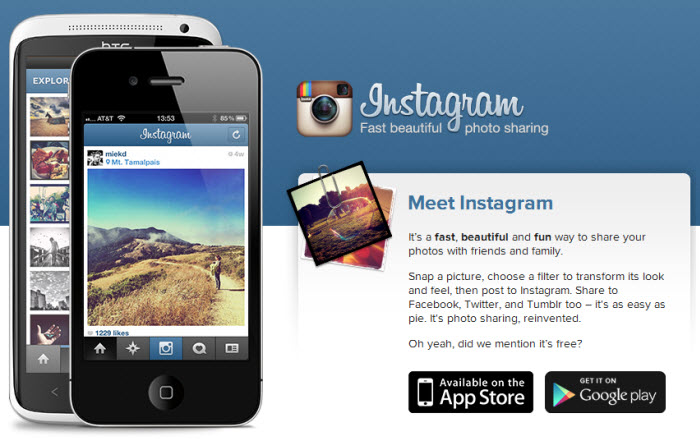
Name: Instagram (username = colbybrownphotography)
User Base: 80+ million users
The Positives:
- Fastest growing mobile photography network
- Simple to use, all images maintain the square look and you only have a small handful of filters to apple to an uploaded image
- It is FUN! It is nice to have a social network for photographers that isn’t professional and serious all the time
- You can post your Instagram photos directly to Facebook, Tumblr, Twitter, Flickr and Foursquare as your upload them to Instagram
The Negatives:
- Instagram has a somewhat negative perception from some “professional” photographers (although I disagree).
- The square limitations to images being uploaded to Instagram can stifle some creativity
- Certain Instagram filters are very popular, leading many images on the network to have the same look and feel
- Instagram is PURELY a mobile photo sharing network currently. Instagram.com is nothing more than a landing page directing you to the IOS and Android store to download the app. There are a few 3rd party websites that allow you to browse Instagram photos on a website, but no official support
- You can NOT share an instagram photo directly to Google+, although this is not Instagram’s fault…it is Google’s.
Summary:
Instagram offers a great fun mobile photo sharing experience. It is fairly simplistic in nature, but many feel that is what makes Instagram so great. Most of its 80 million users are highly active on the network, allowing for a positive social experience for most. Professionally, I use Instagram to share images of my life, travels and family as well as behind the scenes photos of my adventures around the globe. It is a great dumping place for many of my cell phone images that I don’t care to share on my main Social Networks and for that reason I am a huge fan of Instagram.
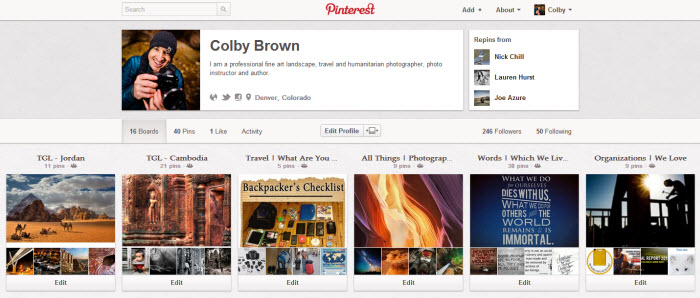
Name: Pinterest
User Base: 23 million as of July (Comscore)
The Positives:
- One of the fastest growing social networks today
- 1.7 billion page views a month
- Simple to use. Create boards to organize your content. Pin content to said boards. Enjoy!
- The whole idea is for content to spread easily.
- You can “pin” content from nearly any website (aside from those that add HTML to block pinning)
- The demographics on the network are heavily in favor of women (90% last I heard)
- Perfect for wedding, portrait photographers
The Negatives:
- Has a relatively small user base
- Some photographers fear its abuse of supposed copyright infringement
- It is not the best network for interaction
- Lacks diversity in over all demographics of users
Summary:
Pinterest is the relatively new kid on the social media block. Because it is new, certain market segments are enthralled…some would even say obsessed with it. While some photographers are worried about supposed copyright infringement, in the vast majority of cases this is a facade. Most users do not upload content directly to Pinterest, instead they “Pin” content they find on other websites to their Pinterest boards. The thumbnail and connected hyperlink than live on that “pin” on your boards, allowing other users to follow it back to the original website. This has potential to help drive traffic back to your own photography website if you leverage your time on Pinterest effectively. However I do not see Pinterest offering much in the way of increasing print sales, finding new contract work or offering anything in the form of education for aspiring photographers. I feel that one has to be fairly active on Pinterest in order to drive enough traffic back to your website in order to see any true gains in the form of selling prints or ebooks. Because the demographics are so heavily swayed towards women, I know many wedding and portrait photographers that are making a killing using Pinterest as a way to meet new clients and connect with Wedding planners in order to secure future jobs. I do however LOVE using Pinterest to find inspiration.
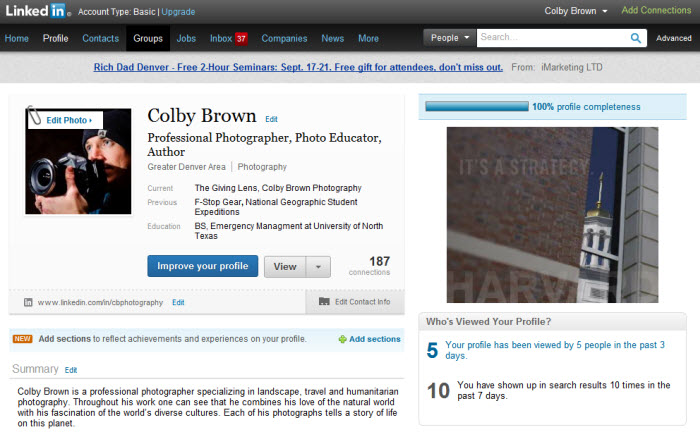
Name: Linked in
User Base: 175 million users (LinkedIN Press Release)
The Positives:
- The only major social network for Professionals
- You can apply to find a new job from Linked in
- Your profile can consist of your resume
- You can easily write and receive the online equivalent of “letters of recommendation” from other professionals you are connected with on the network.
- Stats can tell you how many people have viewed your profile as well as how many times your profile has appeared in search results within Linked in
The Negatives:
- Many people think that those on Linked in are only there to look for jobs
- The different types of interaction possible on Linked in are less than Google+ or Facebook
- There are not to many photographers on Linked in
Summary:
Linked in is the social network for you to maintain and grow professional relationships with other individuals around the globe. As a photographer and entrepreneur, I have found it useful to reach out and connect with PR & Marketing firms, tourism boards and photography related companies to find ways to collaborate on projects. While many photographers request to connect with me on Linked in, I truly see no point. If you are a semi pro or hobbiests that enjoys photography on the side of your normal profession, than I recommend maintaining a profile on the network. In the very least you can connect to any number of photography related “groups” to connect with other photographers to talk “shop”.
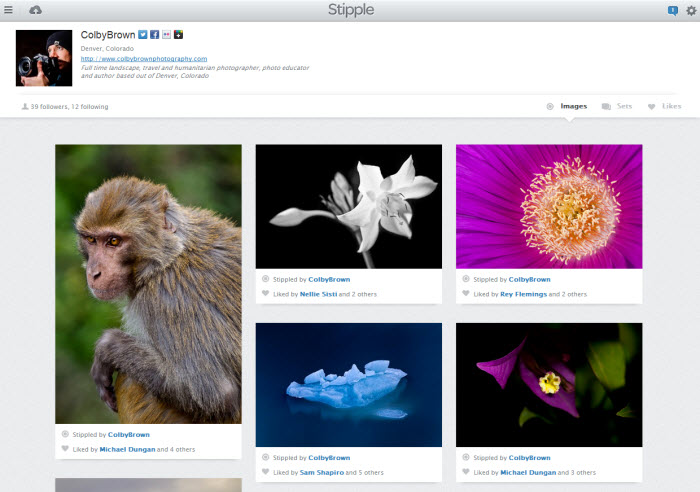
Name: Stipple (New & in BETA Invite only)
User Base: 3000+ Users
The Positives:
- All about attribution. The idea of Stipple is for you to be able to maintain attribution and control over your images as they flow throughout the Internet. (Watch VIDEO demo)
- Images look absolutely gorgeous on Stipple. Arguably better than every other social network.
- You can “pin” extra content to your images, linking to related articles, videos or the ability for the image to be purchased. These pins are maintained on ALL versions of your image out on the Internet when hosted on a Stipple friendly website such as “Tumblr”
- Stats and tracking of your image reach is available, allowing Stipple to tell you how many times your image has been viewed both inside Stipple as well as all connected networks as well as how many people have clicked on your “pins”, giving you a better idea of how well received your photography work is around the net.
- Built in e-commerce support (in Alpha currently)
- Stipple employees are incredibly respective to user feedback. They want its beta users to help improve its product and services at every corner
The Negatives:
- Stipple is in Beta, which means some bugs are present and the feature set is not 100% defined out just yet
Summary:
Stipple is a brand new social network that is just getting started. The focus is geared towards controlling and maintaining the attribution and related content to any of your photographs online. I have been incredibly impressed with just how good my photographs look on Stipple. Because it is in beta, there are a few bugs but overall my experience has been very positive and the features are solid so far. Watch this VIDEO, which will give you a better overall view of Stipple. Even though it is a closed beta, you can apply for an Invite, in which case you will be accepted usually within 24-48 hours.
Developing a Social Media Strategy
When all is said and done, one needs to develop a social networking strategy in order to help make sense of the chaos of the Internet as well as utilize the little time you may have to be online in the most effective manor. No matter if you just want to find other photographers to talk with or if you want to leverage social media to increase your business, going into social media with a game plan is key.
Where Should I Invest My Time?
There is a common misconception by full time photographers that everyone is like us. Take myself for example. I run multiple photography companies, have employees that work for me and spend nearly all of my marketing time online. Do you think that I resemble your average photographer or photo enthusiast? Not by a long shot. While I dedicate a lot of time to social networking and have an active presence on every network I mentioned above, this is not required. I imagine that most of you have other jobs, responsibilities and interests keep you from following your passion for photography 24 hours a day, which includes your time online. You don’t need to listen to the pros that tell you that you have to be everywhere, all the time. It isn’t realistic. Time management is just as vital as having an online presence.
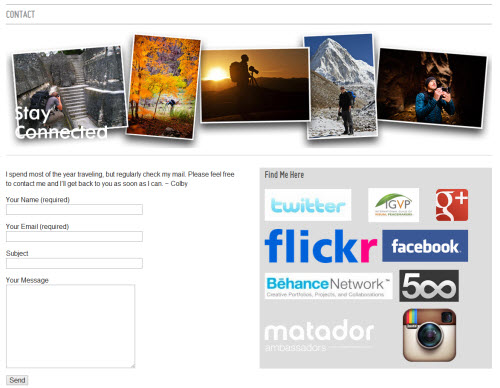
Instead, you should focus your time and energy on the networks that you feel best fit your reasons for being online in the first place. If you are a portrait and wedding photographer that is looking for more clients, Facebook or Pinterest will probably be your best bets. Want to engage with other photographers to find more people like yourself, than you will want to be active on Google+. Are you worried about attribution and copyright, Stipple might be the place for you. Do you just want to have fun sharing mobile photography, Instgram is calling your name.

Long story short, you DO NOT need to be everywhere all the time. Each of these networks offer different kinds of interaction to different market segments. Find the ones that work for you. Over the next few weeks, I will go more in-depth with Facebook, Google+, Twitter, Instagram/Pinterest and Stipple as individual blog posts. Tune in to find our more information.
Check Your Ego At the Door
One of the biggest traps to fall into as a photographer on a social network is to let your own ego cause you problems. The “Popularity Contest” mentality is painful to watch and will end up hurting you in the end. What do I mean by this? If you are on Facebook, Google+ or Twitter and you have ever looked at someone else online and said, “I am a better photographer than that guy (or girl)….why do they have more followers than me”…than you have been sucked into that mentality. I will let everyone in on a little secret right now. Follower numbers have ZERO correlation to the quality of photographer, artist or human being…..never has….never will. Case in point, on Google+ Britney Spears has 4.4 million followers. Lindsey Stirling has 13,000 followers. Lindsey is 100x the song writer and artist of Spears. Wait…did I just reference Britney Spears? Yikes!
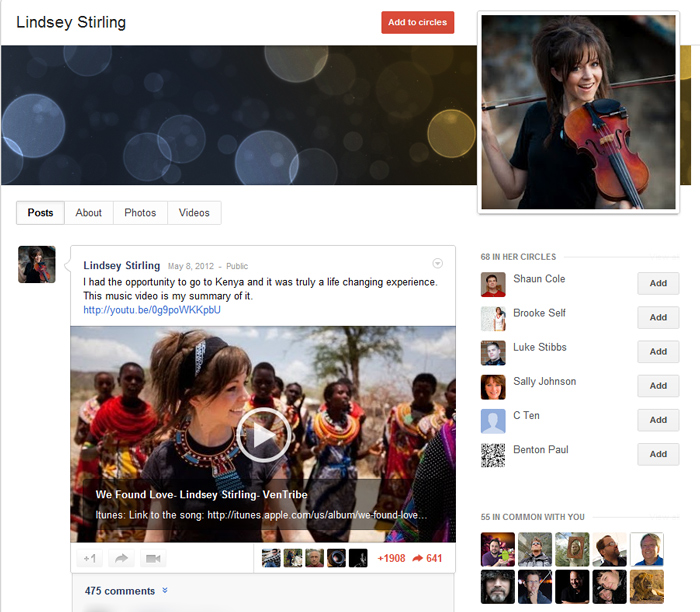
Don’t get caught up in the numbers game. Instead focus on building connections and relationships with the followers you have. After all, it is 100x better to have 100 followers that engage and interact with everything you put out than 1 million that don’t really care.
Engage, Engage, Engage
Strangely, the idea of engagement seems to be a foreign concept with so many photographers online.
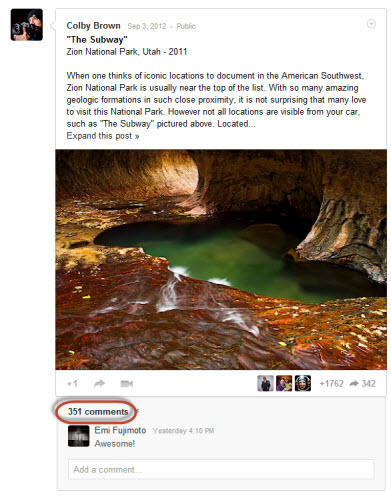
To often I see photographers that expect both followers and interaction to appear out of thin air. One thing to keep in mind is that you are essentially competing with other content every time you post online. Remember our NOISE conversation earlier? So how do you get around this challenge? The answer is simple. Engage. Engage. Engage.
When ever you have an opportunity to engage with other users online in a meaningful way, I highly recommend taking advantage. For some this idea might sounds crazy, but if you get to know and engage with your followers and other individuals online, you have a much higher chance to receive such engagement as well. The general idea is that you want to form your own little community on each of the networks you are active in. Why? So that you have a group of people you can count on for engagement. This is important because of what I call the “snowball effect”. Have you ever walked by a restaurant, looked inside only to see no customers and think…man, do I really want to eat here? My guess is probably not. Now what if that restaurant had a bunch of happy customers? That changes things a little. When it comes to social networks, things are not too different.
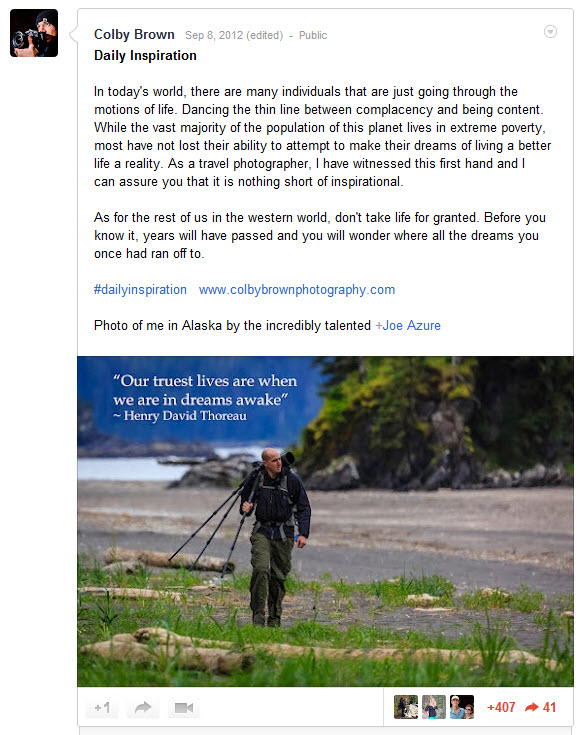
What if I told you that I could tell if one of my posts was going to go viral just by looking at the interaction in the first 20 minutes of it being published? How can I possibly know this? Well, for the following two reasons.
1.) All social networks are geared toward inciting interaction from within the network. Every social networks biggest assets is the content you share on that network. The more engagement, the happier the users. The happier the users, the more they share.
2.) Just like food in a grocery store, a post on any social network has a general life span or shelf life of relevance, that is typically pretty short. Because all of our content is competing with everyone else’s content for attention, it is easy for an amazing post to slip by our eyes without us ever noticing. However every time a post is re-shared or interacted with, the shelf life of that post to extended by a small amount. If a post gets enough interaction early on, it has a forward momentum that can help propel it long enough to encourage more interaction.
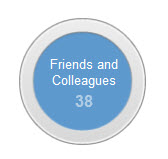
If you have a community around you as a user on any of these networks that engages with your content on a regular basis, you have a leg up and overcoming that first hurdle of extending the life span of your post enough to keep it relevant.
Engaging with other people on line is the “social” part of social networking and social media. Try not to forget that!
It Can’t Be Just About you
I have some bad news for everyone. No matter how good looking, clever or smart. No matter how amazing you are as an artist or human being. You are NOT interesting enough for anyone on this planet to listen to you talk about yourself for 24 hours a day straight. A perfect example is my wife. The love of my life. The one woman that I choose to spend the rest of my life with. If we sat a table together and she just talked about herself for 24 hours straight, even though I love her more than anything…Well, lets just say it wouldn’t be pretty. So why are you any different?
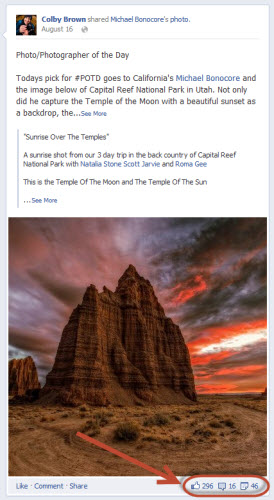
Why am I bringing this up? Too often I see photographers only focus on themselves and never stray beyond that very narrow narrative of itisallaboutme.com. In my professional opinion, I strongly dislike the idea of creating a fan page specifically for your photography, especially if your photography business has your name in it. Why? Because this is a massive crutch for you to just talk about yourself…all day…every day. If you look on Google+ and Facebook, the two largest social networks in existence, you will NOT find a fan/business page for Colby Brown Photography. Why? Because I feel that I am my own brand for every one of my photography companies. This means that my interests and passions outside of photography play a role in shaping who I am, which I feel also effects my photography work and who I am as an artist. If you follow me, you will learn that I love to talk about photography, as well as travel, technology, humanitarian efforts and my family. Even within the subject of photography, you will find that more times than not, I am not just sharing my own photography work, talking about my workshops or pushing out links to purchase my books. Instead you will find me sharing the work of other photographers that I find inspiring (such as Michael Bonocore‘s image above on Facebook), talking about collaborating on projects with my colleagues, and answering questions from other photographers. Why? Because not even I would want to hear my own voice for 24 hours a day, every day of the year.
Social Media for Photographers ebook
In Q1 of 2013 I will be releasing a new ebook titled “Social Media for Photographers”. It will not only contain all of the updated information in this post for that time frame, but also expand upon the idea of developing a social media strategy as well as offering in-depth tips and tricks for each of the major social networks. The book will cost around $4.99. Below is a sign up page to be notified of its launch.
Wrapping Up
As I mentioned previously, I will be publishing a series of posts that focus on some of the more prevalent social networks for photographers in the coming weeks, giving you a more in-depth look at these platforms and sharing my tips and tricks for maximizing your time at each of these sites.


